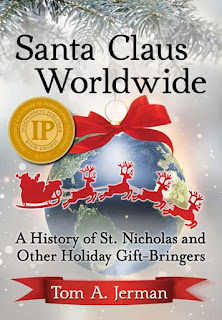History Corner: Santa Claus Worldwide: A History of St. Nicholas and Other Midwinter Gift-Bringers by Tom A Jerman
Disclosure / Disclaimer: I received this ebook, free of charge,from McFarland & Co Books via Netgalley, for review purposes on this blog. No other compensation, monetary or in kind, has been received or implied for this post. Nor was I told how to post about it. All opinions are my own.
The 200-year legacy of the American Santa Claus as we know him is meticulously documented and explained in author Tom Jerman’s fascinating new book, Santa Claus Worldwide: A History of St. Nicholas and Other Holiday Gift-Bringers.
Readers will be surprised to learn Santa’s true origin story (hint: it wasn’t in Clement C. Moore’s popular poem, “The Night Before Christmas”), plus they’ll be treated to a deep dive into the backstories of other midwinter gift-givers from all over the globe. Jerman’s exhaustive research is evident in his detailed descriptions, and he masterfully showcases the rich diversity among the characters while also pointing out shared traits.
Readers will discover:
• How midwinter gift-givers developed over thousands of years;
• The difference between Catholic followers of St. Nicholas and Protestant followers of the secular “terror men” in Europe following the Reformation;
• Historical examples of midwinter gift-givers who were female, Black, rich, gay, atheist and communist;
• When and how a New York printer named William Gilley created the “American Santa Claus” in an 1821 booklet, The Children’s Friend;
• How a wealthy New York professor, Clement C. Moore, bought a copy of The Children’s Friend and, in 1822, wrote “The Night Before Christmas;” and
• How The Children’s Friend disappeared from history until it was rediscovered in 1953.
Ultimately, Santa Claus Worldwide proves, conclusively, the existence of Santa and his impact on our world.
“Santa indisputably exists as the symbol of Christmas, and Christmas represents our most noble virtues,” Jerman says. “Symbols are real, and they can be very powerful.”
Review:
We;ve reviewed a few Christmas books, including those taking about the holiday traditions, here on this blog before. This book is the next level- it takes on the idea of SANTA and delves into how he evolved in different parts of the world. It's an interesting look at a tradition that most take for granted, but which is really more of a modern concept.The book shines when it discussed the ancient traditions of Christmas and the debut of Father Nicholas- it's obvious the author did a great amoount of research there! From the early days he looks at how Father Christmas debuted and changed in different areas across the globe. There are interesting takes in the world section that you might not know about (ie Germany/Nazithe Yule Lads of Iceland and the Russian Snow Maiden, My only quibble in the world section is the section on the Irish traditions, which seems like a thrown in, rather than researched- ie Women's Christmas is left out, but could have been mentioned, as other end of the season events are for other countries. The last sections focus on the American Santa and how he influenced the rest of the world. These also shine, as they include plenty of illustrations to show how Snata evolved form his premier in marketing items in the 1820s to more modern look of the twentieth century. It's an interesting book and perfect for gift giving for hostesses/hosts this holiday season, or for the
About the Author
Tom A. Jerman, a resident of Asheville, N.C., has bachelor’s degrees in philosophy and journalism and a juris doctorate degree from the University of Utah. Employed as a copy editor with The Salt Lake Tribune between 1974-78, he went on to practice labor and employment law for 35 years. In 2015, he took early retirement to pursue his desire to write something more interesting and enduring than legal treatises.
A serious collector, Jerman has amassed some 4,500 Santa figurines and ornaments, and thousands of antique postcards printed between 1900 and 1910. The enormous diversity of figures — temporal, geographic, historical, size, attire, date of gift-giving, mode of travel — prompted him to write Santa Claus Worldwide, the first volume of a planned trilogy.
For more information, please visit http://acollectionofsantas.com

Comments
Post a Comment